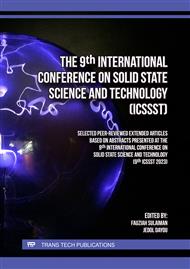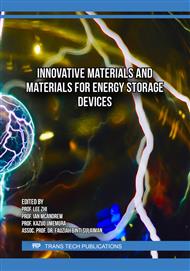[1]
M. Usha Rani, K. Nanaji, T.N. Rao, A.S. Deshpande, Corn husk derived activated carbon with enhanced electrochemical performance for high-voltage supercapacitors, J. Power Sources. 471 (2020) 228387.
DOI: 10.1016/j.jpowsour.2020.228387
Google Scholar
[2]
L. Liu, N. Solin, O. Inganäs, Self-discharge study of lignin/graphite hybrid material electrodes, Electrochim. Acta. 371 (2021) 137836 https://doi.org/10.1016/j.electacta. 2021.137836.
DOI: 10.1016/j.electacta.2021.137836
Google Scholar
[3]
R. Farma, M. Deraman, S. Soltaninejad, E. Taer, M.M. Ishak, N.S.M. Nor, N.H. Basri, B.N.M. Dolah, N.K. Othman, M.A.R. Othman, R. Daik, M. Suleman, G. Hegde, A New Approach towards Improving the Specific Energy and Specific Power of a Carbon-Based Supercapacitor using Platinum-Nanoparticles on Etched Stainless Steel Current Collector, Electrochemistry. 83 (2015) 1053–1060.
DOI: 10.5796/electrochemistry.83.1053
Google Scholar
[4]
B.E. Conway, W.G. Pell, T.-C. Liu, Diagnostic analyses for mechanisms of self-discharge of electrochemical capacitors and batteries, J. Power Sources. 65 (1997) 53–59.
DOI: 10.1016/S0378-7753(97)02468-3
Google Scholar
[5]
M. Kaus, J. Kowal, D.U. Sauer, Modelling the effects of charge redistribution during self-discharge of supercapacitors, Electrochim. Acta. 55 (2010) 7516–7523.
DOI: 10.1016/j.electacta.2010.01.002
Google Scholar
[6]
Y. Diab, P. Venet, H. Gualous, G. Rojat, Self-Discharge Characterization and Modeling of Electrochemical Capacitor Used for Power Electronics Applications, IEEE Trans. Power Electron. 24 (2009) 510–517.
DOI: 10.1109/TPEL.2008.2007116
Google Scholar
[7]
W. Viola, C. Jin, T.L. Andrew, Self-discharge characteristics of vapor deposited polymer electrodes in an all-textile supercapacitor, Synth. Met. 268 (2020) 116483.
DOI: 10.1016/j.synthmet.2020.116483
Google Scholar
[8]
X. Su, W. Jia, H. Ji, Y. Zhu, Mitigating self-discharge of activated carbon-based supercapacitors with hybrid liquid crystal as an electrolyte additive, J. Energy Storage. 41 (2021) 102830.
DOI: 10.1016/j.est.2021.102830
Google Scholar
[9]
M. Xia, J. Nie, Z. Zhang, X. Lu, Z.L. Wang, Suppressing self-discharge of supercapacitors via electrorheological effect of liquid crystals, Nano Energy. 47 (2018) 43–50.
DOI: 10.1016/j.nanoen.2018.02.022
Google Scholar
[10]
S. Devese, T. Nann, Suppressed self-discharge of an aqueous supercapacitor using Earth-abundant materials, J. Electroanal. Chem. 871 (2020) 114307.
DOI: 10.1016/j.jelechem.2020.114307
Google Scholar
[11]
Y. Du, Y. Mo, Y. Chen, Effects of Fe Impurities on Self-Discharge Performance of Carbon-Based Supercapacitors, Materials (Basel). 14 (2021) 1908.
DOI: 10.3390/ma14081908
Google Scholar
[12]
M. Shi, Z. Zhang, M. Zhao, X. Lu, Z.L. Wang, Reducing the Self-Discharge Rate of Supercapacitors by Suppressing Electron Transfer in the Electric Double Layer, J. Electrochem. Soc. 168 (2021) 120548.
DOI: 10.1149/1945-7111/ac44b9
Google Scholar
[13]
E. Taer, Apriwandi, Windasari, R. Taslim, M. Deraman, Novel laurel aromatic evergreen biomass derived hierarchical porous carbon nanosheet as sustainable electrode for high performance symmetric supercapacitor, J. Energy Storage. 67 (2023) 107567.
DOI: 10.1016/j.est.2023.107567
Google Scholar
[14]
M. Suleman, M. Deraman, M.A.R. Othman, R. Omar, M.A. Hashim, N.H. Basri, N.S.M. Nor, B.N.M. Dolah, M.F.Y.M. Hanappi, E. Hamdan, N.E.S. Sazali, N.S.M. Tajuddin, M.R.M. Jasni, Electric double-layer capacitors with tea waste derived activated carbon electrodes and plastic crystal based flexible gel polymer electrolytes, J. Phys. Conf. Ser. 739 (2016) 012086.
DOI: 10.1088/1742-6596/739/1/012086
Google Scholar
[15]
R. Farma, I. Apriyani, Awitdrus, M. Deraman, E. Taer, R.N. Setiadi, A.S. Rini, Enhanced electrochemical performance of oxygen, nitrogen, and sulfur trial-doped Nypa fruticans-based carbon nanofiber for high performance supercapacitors, J. Energy Storage. 67 (2023) 107611.
DOI: 10.1016/j.est.2023.107611
Google Scholar
[16]
A.. Coutinho, J.. Rocha, C.. Luengo, Preparing and characterizing biocarbon electrodes, Fuel Process. Technol. 67 (2000) 93–102.
DOI: 10.1016/S0378-3820(00)00091-6
Google Scholar
[17]
M. Deraman, I.A. Talib, M.R. Omar, H.H.J. Jumali, E. Taer, M.M. Saman, Awitdrus, E. Taer, M. Deraman, I.A. Talib, R. Omar, M.H. Jumali, M.M. Saman, Microcrystallite dimension and total active surface area of carbon electrode from mixtures of Pre-Carbonized oil palm empty fruit bunches and green petroleum cokes, Sains Malaysiana. 39 (2010) 83–86. http://inis.iaea.org/Search/search.aspx?orig_q=RN:45088682 (accessed July 9, 2015).
DOI: 10.1063/1.4757187
Google Scholar
[18]
N. Mustapar, M.A.R. Othman, M.S. Su'ait, M. Suleman, W.Y. Wong, K.S. Loh, Supercapacitor performance gains from structural modification of carbon electrodes using gamma radiations, J. Electrochem. Sci. Eng. (2022).
DOI: 10.5599/jese.1224
Google Scholar
[19]
R. Farma, M. Deraman, Awitdrus, I. a. Talib, R. Omar, J.G. Manjunatha, M.M. Ishak, N.H. Basri, B.N.M. Dolah, Physical and electrochemical properties of supercapacitor electrodes derived from carbon nanotube and biomass carbon, Int. J. Electrochem. Sci. 8 (2013) 257–273.
DOI: 10.1063/1.4917096
Google Scholar
[20]
M. Khalfaoui, S. Knani, M.A. Hachicha, A.B. Lamine, New theoretical expressions for the five adsorption type isotherms classified by BET based on statistical physics treatment, J. Colloid Interface Sci. 263 (2003) 350–356.
DOI: 10.1016/S0021-9797(03)00139-5
Google Scholar
[21]
F.-C. Wu, R.-L. Tseng, C.-C. Hu, C.-C. Wang, The capacitive characteristics of activated carbons—comparisons of the activation methods on the pore structure and effects of the pore structure and electrolyte on the capacitive performance, J. Power Sources. 159 (2006) 1532–1542.
DOI: 10.1016/j.jpowsour.2005.12.023
Google Scholar
[22]
E. Taer, M. Deraman, I.A. Talib, S.A. Hashmi, A.A. Umar, Growth of platinum nanoparticles on stainless steel 316L current collectors to improve carbon-based supercapacitor performance, Electrochim. Acta. 56 (2011) 10217–10222.
DOI: 10.1016/j.electacta.2011.09.007
Google Scholar
[23]
Y.-J. Kim, B.-J. Lee, H. Suezaki, T. Chino, Y. Abe, T. Yanagiura, K.C. Park, M. Endo, Preparation and characterization of bamboo-based activated carbons as electrode materials for electric double layer capacitors, Carbon N. Y. 44 (2006) 1592–1595.
DOI: 10.1016/j.carbon.2006.02.011
Google Scholar
[24]
R.S. Salama, M.S. Gouda, M.F.A. Aboud, F.T. Alshorifi, A.A. El-Hallag, A.K. Badawi, Synthesis and characterization of magnesium ferrite-activated carbon composites derived from orange peels for enhanced supercapacitor performance, Sci. Rep. 14 (2024) 8223.
DOI: 10.1038/s41598-024-54942-9
Google Scholar
[25]
S. Li, X. Tan, H. Li, Y. Gao, Q. Wang, G. Li, M. Guo, Investigation on pore structure regulation of activated carbon derived from sargassum and its application in supercapacitor, Sci. Rep. 12 (2022) 10106.
DOI: 10.1038/s41598-022-14214-w
Google Scholar
[26]
L.-Q. Mai, A. Minhas-Khan, X. Tian, K.M. Hercule, Y.-L. Zhao, X. Lin, X. Xu, Synergistic interaction between redox-active electrolyte and binder-free functionalized carbon for ultrahigh supercapacitor performance, Nat. Commun. 4 (2013) 2923.
DOI: 10.1038/ncomms3923
Google Scholar
[27]
H. Yu, J. Wu, L. Fan, K. Xu, X. Zhong, Y. Lin, J. Lin, Improvement of the performance for quasi-solid-state supercapacitor by using PVA–KOH–KI polymer gel electrolyte, Electrochim. Acta. 56 (2011) 6881–6886.
DOI: 10.1016/j.electacta.2011.06.039
Google Scholar
[28]
K.-M. Kim, J.-W. Hur, S.-I. Jung, A.-S. Kang, Electrochemical characteristics of activated carbon/Ppy electrode combined with P(VdF-co-HFP)/PVP for EDLC, Electrochim. Acta. 50 (2004) 863–872.
DOI: 10.1016/j.electacta.2004.02.059
Google Scholar
[29]
N.S.M. Nor, M. Deraman, M. Suleman, M.R.M. Jasni, J.G. Manjunatha, M.A.R. Othman, S.A. Shamsudin, Supercapacitors using binderless activated carbon monoliths electrodes consisting of a graphite additive and pre-carbonized biomass fibers, Int. J. Electrochem. Sci. 12 (2017).
DOI: 10.20964/2017.03.48
Google Scholar
[30]
A.I. Inamdar, Y. Kim, S.M. Pawar, J.H. Kim, H. Im, H. Kim, Chemically grown, porous, nickel oxide thin-film for electrochemical supercapacitors, J. Power Sources. 196 (2011) 2393–2397.
DOI: 10.1016/j.jpowsour.2010.09.052
Google Scholar



